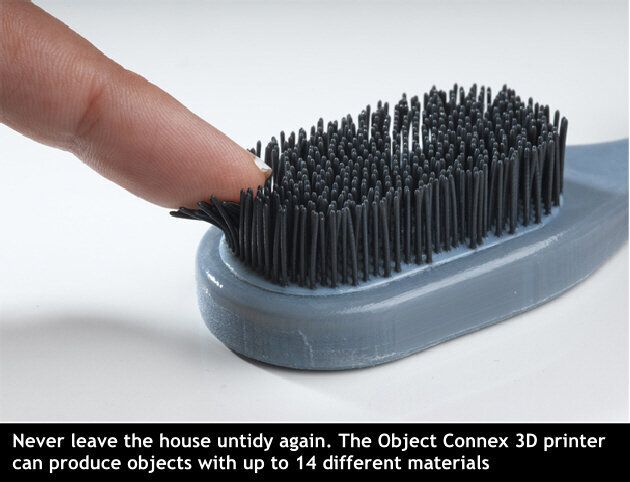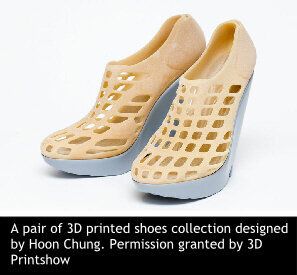With this weekend's 3D Printshow almost sold out, interest in a technology that promises to change the world, is clearly high. But how will a 3D chocolate brain, tree sculpture and helmet from The Iron Man boost economies, save lives and get us to Mars?

Well, in actual fact, lots. They are just a few of the many exhibits at the 3D Printshow and, for me, it will be a chance to really see the future of where this technology is going. When creative minds explore new technology, it is an incredibly exciting time, as technology is nothing without imagination. Almost daily there is a new announcement about 3D printing and the social ramifications of its advancement and, like most disruptive technologies, it both excites and concerns.
First of all, what is 3D printing? Generally, it involves building up an object layer by layer, from a range of materials such as sand, glass, plastic, metal and even paper. This technique allows for the production of individual bespoke products, without the cost and waste of a traditional assembly line.
With less shipping requirements, production can be more localised and prototyping speeded up. Combined with a scanner, you can even effectively make 3D photocopies of real objects!
We have a while to go before absent minded people like myself can replicate lost keys and phones. Low cost 3D printers such as the $1800 MakerBot Replicator or $1300 Cube from 3D Systems, are impressive but still the reserve of prosumers. At that price point, objects have limited practical uses. However, MIT Media Lab plan to launch a low cost high resolution 3D printer capable of producing objects that are refined enough to replace parts or materialise complex jewellery designs that were once in your head. With over $2 million already pledged on Kickstarter, the FORM-1 might be a major step forward towards putting disposable cutlery makers out of business at least.
One of the biggest concerns is that the technology could threaten intellectual copyright laws in a more dramatic way than the Internet did. After all, if you can download a blueprint to instruct your home 3D printer to layer up a new chair, how would that 'instruction' be protected against copyright theft?
Former Microsoft CTO Nathan Myhrvold has recently achieved an expansive patent on 3D printing Digital Rights Management to prevent users of 3D printers from plagiarising object rights. The principle is that, before any printing takes place, a remote server would check you are authorised to print the object from a digital file.
While lawyers, economists and commentators debate the impact on order, the economy and society, this weekend's 3D Printshow will be a hub of creative minds using the technology to create value, inspire and even have some fun with.
The term '3D' has recaptured the public's imagination but rather than the virtual world of 3D television, it's the tangible world of 3D printing that has the media talking.
What has especially grabbed my attention is Inition's range of exhibits including a chocolate brain. The Shoreditch based company acquired its first 3D printer in 2005 and were responsible for scanning and 3D printing a replica of John Cleese's head for gadget show Batteries Not Included.
Guests will encounter a life-sized chocolate model of Inition co-founder Andy Millns' brain, created using MRI data and 3D printing technology.
Inition's 3D print team used the sliced image data from a scan Millns previously had. This has been converted into a STL file format (a 3D geometry format widely used for 3D printing), which was fed to a 3D printer to craft an exact replica of his brain. Liquid silicone was poured on, creating a hollow mould for the chocolate to form the shape of his cerebral cortex.
The following video features Andy Millns eating his chocolate brain as part of an Instructables competition in the summer.
Rob Jeffries, 3D Scanning and Printing Consultant, Inition, tells me that this is a novel way to showcase potential practical uses: "A wide range of companies have utlised our 3D printing technology and services and we are looking forward to showing 3D Printshow visitors how, by combining 3D printing with other technologies, you can open up a world of possibilities. A more serious example of this approach is an application we conceived with our architectural client Zaha Hadid. By creating an AR application and 3D printed model of a Zaha Hadid designed museum, guests will be able to use an iPad to view superimposed layers on a real-world model. This could offer massive benefits for various industries who want to improve collaboration and visualisation of projects during the design stage."
Referring to the more flavoursome project, Jeffries said: "Re-producing our co-founder's brain in chocolate has been a lot of fun, especially as we had plenty of chocolate left over, but it also opens up the potential of other applications by combining MRI data with 3D printing technology."

It is not the first time 3D printing has got chocolaty. Dr Liang Hao, from the University of Exeter, founded Choc Edge Ltd, a company that could strike fear into chocolatiers around the world. The Choc Creator is the world's first commercial 3D chocolate printer that produces simple chocolate designs using CAD software rather than a piping bag and recipe book. Carb lovers at Google don't need to put up with generic food either, as a 3D printer in the Google HQ kitchen can design custom pasta shapes for diners (Fusilli is so dull after all!)
Other cool stuff will be a live fashion show where all clothes, jewellery and hats will have come out of a printer; a full-body scanner will scan and reproduce visitors at the size of a mouse; a wood consisting of individually printed trees where the thickness of the trunk, number of branches and colour of the tips are all based on online survey results, and a digital home where everything, from the lights to the furniture, have been 3D printed.
So while some of these might initially sound gimmicky, from humble beginnings come great things. A chocolate brain can lead to improved medical training tools; a printed tree sculpture can lead to giant structures in space and an Iron Man helmet could lead to more effective life saving bespoke helmets designed for cyclists.
We may have read the recent horror story about 3D printed guns but 3D printing appears to offer the potential to affect so many aspects of our lives for the better.
The 3D Printshow takes place at The Brewery, London EC1 from 19-21 October. For more information visit 3dprintshow.com.